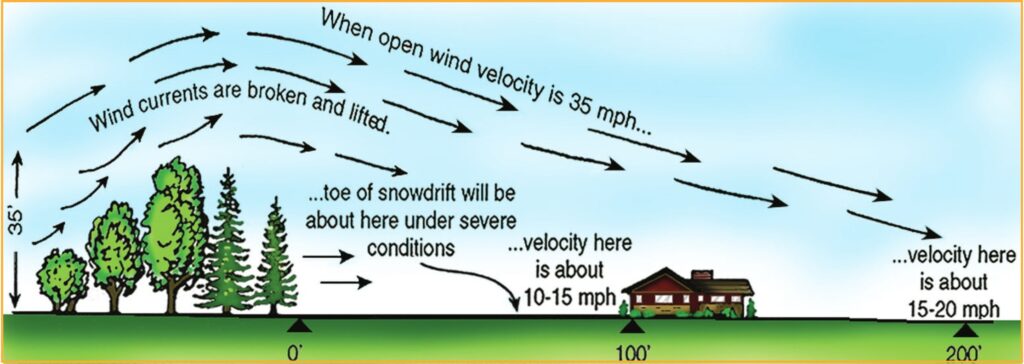
Harnessing the power of nature to create a more comfortable and sustainable living environment is a growing trend. One often overlooked method is utilizing trees as natural windbreaks. By strategically planting trees, you can effectively reduce wind speed on your property, creating a calmer microclimate that benefits both people and plants. This article will delve into the science behind how trees act as wind barriers, explore the numerous advantages they offer, and provide practical guidance on planting for optimal wind protection.
This comprehensive guide will cover the fundamentals of natural windbreaks, examining the mechanisms by which trees deflect wind and create calmer environments. We’ll then discuss the multifaceted benefits of incorporating trees into your landscape design, ranging from enhanced comfort to improved plant growth. Finally, we’ll provide actionable tips on selecting appropriate tree species and planting techniques to maximize wind protection for your property.
Natural Windbreaks
Trees function as natural windbreaks by acting as physical barriers that intercept and deflect wind gusts. Their dense canopies and branching structures create resistance to airflow, slowing down wind speed and reducing its impact on the surrounding area. The effectiveness of a windbreak depends on several factors, including the density and height of the trees, their spacing, and the prevailing wind direction.
The shape and arrangement of leaves also play a role in wind deflection. Broad, flat leaves create more surface area for air resistance, while needle-like leaves offer less resistance. Planting trees in rows or clusters can further enhance windbreak effectiveness by creating multiple layers of interception.
Benefits of Trees as Wind Barriers
Establishing natural windbreaks on your property offers a wide range of benefits that extend beyond simply reducing wind speed. These advantages contribute to a more comfortable, sustainable, and aesthetically pleasing environment.
Enhanced Comfort
Wind can create discomfort by chilling us, drying out our skin, and making outdoor activities less enjoyable. By planting trees as windbreaks, you can create sheltered areas where the wind is significantly reduced, allowing for greater comfort during outdoor activities like gardening, relaxing on a patio, or simply enjoying fresh air.
Protection for Plants
Strong winds can damage delicate plants by causing physical injury, drying out soil, and increasing the risk of disease. Windbreaks protect vulnerable plants from these damaging effects, creating a more favorable growing environment. This is particularly beneficial for young trees and seedlings that are more susceptible to wind damage.
Reduced Energy Costs
Wind can significantly impact heating and cooling costs in buildings. By reducing wind speed around your home, natural windbreaks can help maintain a more stable indoor temperature, potentially leading to lower energy bills.
Microclimate Regulation
Trees play a crucial role in regulating microclimates, creating localized weather patterns that differ from the surrounding environment. Windbreaks contribute to this by influencing air circulation and temperature gradients within a specific area.
Temperature Moderation
Trees can help moderate temperatures by providing shade during hot periods and acting as windbreaks that prevent cold air from penetrating sheltered areas. This creates a more comfortable living environment, especially in regions with extreme temperature fluctuations.
Increased Humidity
The transpiration process, where trees release water vapor into the atmosphere, contributes to increased humidity levels within their immediate vicinity. This can benefit plants by reducing water loss and creating a more favorable growing environment.
Planting for Optimal Wind Protection
To maximize the effectiveness of your windbreak, consider these factors when selecting tree species and planting techniques:
Tree Selection
Choose tree species that are well-suited to your climate and soil conditions. Consider their mature size, growth rate, and branching structure. Densely branched trees with broad canopies are generally more effective windbreaks than those with sparse foliage.
Spacing and Arrangement
Plant trees in rows or clusters, spacing them according to the desired density and the mature size of the species. A staggered planting pattern can further enhance windbreak effectiveness by creating multiple layers of interception.
Maintenance
Regular pruning is essential for maintaining the health and effectiveness of your windbreak. Remove dead or diseased branches, and shape the trees to promote dense growth and optimal wind deflection.
Conclusion
Planting trees as natural windbreaks offers a multitude of benefits for both people and the environment. By strategically incorporating trees into your landscape design, you can create calmer microclimates, enhance comfort, protect plants from wind damage, and contribute to a more sustainable living environment. Remember to carefully select tree species, consider planting techniques, and provide regular maintenance to ensure your windbreak thrives and delivers its full potential.
